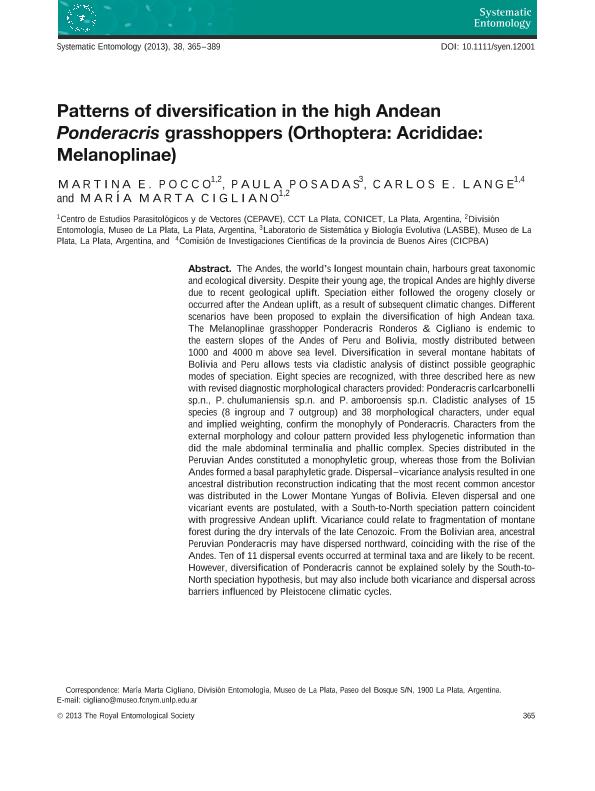Mostrar el registro sencillo del ítem
dc.contributor.author
Pocco, Martina Eugenia

dc.contributor.author
Posadas, Paula Elena

dc.contributor.author
Lange, Carlos Ernesto
dc.contributor.author
Cigliano, Maria Marta

dc.date.available
2017-01-13T15:04:28Z
dc.date.issued
2012-11
dc.identifier.citation
Pocco, Martina Eugenia; Posadas, Paula Elena; Lange, Carlos Ernesto; Cigliano, Maria Marta; Patterns of diversification in the high Andean Ponderacris grasshoppers (Orthoptera: Acrididae: Melanoplinae); Wiley; Systematic Entomology (print); 38; 2; 11-2012; 365–389
dc.identifier.issn
0307-6970
dc.identifier.uri
http://hdl.handle.net/11336/11279
dc.description.abstract
The Andes, the world’s longest mountain chain, harbours great taxonomic and ecological diversity. Despite their young age, the tropical Andes are highly diverse due to recent geological uplift. Speciation either followed the orogeny closely or occurred after the Andean uplift, as a result of subsequent climatic changes. Different scenarios have been proposed to explain the diversification of high Andean taxa. The Melanoplinae grasshopper Ponderacris Ronderos & Cigliano is endemic to the eastern slopes of the Andes of Peru and Bolivia, mostly distributed between 1000 and 4000 m above sea level. Diversification in several montane habitats of Bolivia and Peru allows tests via cladistic analysis of distinct possible geographic modes of speciation. Eight species are recognized, with three described here as new with revised diagnostic morphological characters provided: Ponderacris carlcarbonelli sp.n., P. chulumaniensis sp.n. and P. amboroensis sp.n. Cladistic analyses of 15 species (8 ingroup and 7 outgroup) and 38 morphological characters, under equal and implied weighting, confirm the monophyly of Ponderacris. Characters from the external morphology and colour pattern provided less phylogenetic information than did the male abdominal terminalia and phallic complex. Species distributed in the Peruvian Andes constituted a monophyletic group, whereas those from the Bolivian Andes formed a basal paraphyletic grade. Dispersal–vicariance analysis resulted in one ancestral distribution reconstruction indicating that the most recent common ancestor was distributed in the Lower Montane Yungas of Bolivia. Eleven dispersal and one vicariant events are postulated, with a South-to-North speciation pattern coincident with progressive Andean uplift. Vicariance could relate to fragmentation of montane forest during the dry intervals of the late Cenozoic. From the Bolivian area, ancestral Peruvian Ponderacris may have dispersed northward, coinciding with the rise of the Andes. Ten of 11 dispersal events occurred at terminal taxa and are likely to be recent. However, diversification of Ponderacris cannot be explained solely by the South-toNorth speciation hypothesis, but may also include both vicariance and dispersal across barriers influenced by Pleistocene climatic cycles.
dc.format
application/pdf
dc.language.iso
eng
dc.publisher
Wiley

dc.rights
info:eu-repo/semantics/openAccess
dc.rights.uri
https://creativecommons.org/licenses/by-nc-sa/2.5/ar/
dc.subject
Melanoplinae
dc.subject
High Andes
dc.subject
Dispersal-Vicariance Analysis
dc.subject
Phylogeny
dc.subject.classification
Zoología, Ornitología, Entomología, Etología

dc.subject.classification
Ciencias Biológicas

dc.subject.classification
CIENCIAS NATURALES Y EXACTAS

dc.title
Patterns of diversification in the high Andean Ponderacris grasshoppers (Orthoptera: Acrididae: Melanoplinae)
dc.type
info:eu-repo/semantics/article
dc.type
info:ar-repo/semantics/artículo
dc.type
info:eu-repo/semantics/publishedVersion
dc.date.updated
2017-01-13T14:00:41Z
dc.identifier.eissn
1365-3113
dc.journal.volume
38
dc.journal.number
2
dc.journal.pagination
365–389
dc.journal.pais
Estados Unidos

dc.journal.ciudad
Hoboken
dc.description.fil
Fil: Pocco, Martina Eugenia. Consejo Nacional de Investigaciones Científicas y Técnicas. Centro Científico Tecnológico la Plata. Centro de Estudios Parasitológicos y de Vectores (i); Argentina. Universidad Nacional de La Plata. Facultad de Ciencias Naturales y Museo. División Entomología; Argentina
dc.description.fil
Fil: Posadas, Paula Elena. Universidad Nacional de la Plata. Facultad de Ciencias Naturales y Museo. Laboratorio de Sistemática y Biología Evolutiva; Argentina. Consejo Nacional de Investigaciones Científicas y Técnicas; Argentina
dc.description.fil
Fil: Lange, Carlos Ernesto. Consejo Nacional de Investigaciones Científicas y Técnicas. Centro Científico Tecnológico la Plata. Centro de Estudios Parasitológicos y de Vectores (i); Argentina. Provincia de Buenos Aires. Gobernación. Comisión de Investigaciones Científicas; Argentina. Universidad Nacional de La Plata; Argentina
dc.description.fil
Fil: Cigliano, Maria Marta. Consejo Nacional de Investigaciones Científicas y Técnicas. Centro Científico Tecnológico la Plata. Centro de Estudios Parasitológicos y de Vectores (i); Argentina. Universidad Nacional de La Plata. Facultad de Ciencias Naturales y Museo. División Entomología; Argentina
dc.journal.title
Systematic Entomology (print)

dc.relation.alternativeid
info:eu-repo/semantics/altIdentifier/doi/http://dx.doi.org/10.1111/syen.12001
dc.relation.alternativeid
info:eu-repo/semantics/altIdentifier/url/http://onlinelibrary.wiley.com/doi/10.1111/syen.12001/abstract
Archivos asociados
